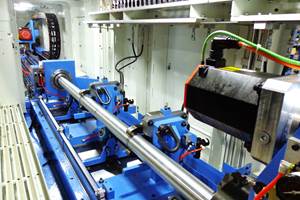More Effective Deep-Hole Drilling with MQL
A dual-margin design enables a series of drills from Nachi to create holes with large length-to-diameter ratios with minimum quantity lubrication.
Share





An increasing number of shops are considering minimum quantity lubrication (MQL). MQL delivers a very small amount of coolant to a cutter’s edge in the form of an oil mist or aerosol, as opposed to traditional techniques of flooding the workpiece and tool with a substantial volume of liquid coolant. The lubricant is mixed with air to form the desired air/oil aerosol mixture, and the aerosol is then sent to the cutting edge through ducts in the tool. Just a tiny bit of that aerosol is left on the chips, workpiece and machine during the cutting operation.
MQL lowers machining costs by eliminating not only the large volume of coolant used in conventional wet operations, but also all the ancillary equipment and electrical power necessary to maintain a big, central coolant system. MQL also creates a cleaner, safer manufacturing environment, which is beneficial to the health of both the equipment used on the shop floor and the employees who work there.
However, when using MQL with conventional long high speed steel (HSS) drills that have a single-margin design, many pecking cycles are commonly needed to provide adequate chip evacuation and stability. Conversely, Nachi’s Aqua EX MQL drills use a dual-margin geometry to enable MQL drilling with length-to-diameter (L/D) ratios ranging to 30:1 without time-consuming retract/re-entry pecking cycles. (Special-order drills can be made in L/D ratios as high as 50:1). The company says these drills are well-suited for creating oil-passage holes for crankshafts, mold cooling holes, and related applications requiring deep, small-diameter holes.
According to the company, the Aqua EX MQL drill’s double margin increases drilling straightness and stability by better controlling drill bending and swelling compared to single-margin designs. In addition, a J-shaped cutting edge with hollow center shape is said to forcibly break up curled chips, while an optimum web diameter offers a balance between chip-removal capability and tool rigidity.
The Aqua EX MQL drills have a TiAlN base plus an AlCrTi nano-layer coating for heat and wear resistance. Additionally, a lubrication film is applied to the top layer of coating to facilitate chip evacuation and limit chip packing. This coating is applied only to the drill tip, which extends the life of the grinding wheel when the drill is reground. (Drills can be reground and re-coated as many as five times.)
A test cut performed by the company shows the performance difference between an Aqua EX MQL drill and a conventional single-margin HSS drill in creating a 5-mm hole to a depth of 100 mm in S53C carbon steel. At a cutting speed of 20 m/min. and feed rate of 150 mm/min., the HSS drill created the hole in 51 seconds and required seven pecking cycles. The Aqua EX MQL drill created the hole in 10 seconds without pecking at a cutting speed of 80 m/min. and feed rate of 750 mm/min.
The Aqua EX MQL drills are available in 10:1 and 15:1 L/D versions in diameters ranging from 1.0 to 12.0 mm. The 20:1 version is available from 1.0 to 10.0 mm; the 25:1 and 30:1 L/D versions range in diameter from 3.0 to 10 mm. The company recommends pre-drilling guide holes to a depth of two to three times the diameter prior to the deep-hole drilling operation.
Related Content
Tungaloy Drills, Milling Inserts Provide Enhanced Stability
Tungaloy has expanded its DrillForceMeister and TecMill lines with new drill bodies and milling inserts.
Read MoreKennametal's Expanded Tooling Portfolio Improves Performance
The company has launch eight new products that expand on and support existing platforms across multiple applications.
Read MoreForm Tapping Improves Tool Life, Costs
Moving from cut tapping to form tapping for a notable application cut tooling costs at Siemens Energy and increased tool life a hundredfold.
Read MoreKay Engineering's Gundrilling Machine Performs Range of Operations
Kay Engineering’s DeHoff 20144 is used to perform gundrilling, pull boring, roller burnishing and thread tapping.
Read MoreRead Next
5 Rules of Thumb for Buying CNC Machine Tools
Use these tips to carefully plan your machine tool purchases and to avoid regretting your decision later.
Read MoreRegistration Now Open for the Precision Machining Technology Show (PMTS) 2025
The precision machining industry’s premier event returns to Cleveland, OH, April 1-3.
Read MoreSetting Up the Building Blocks for a Digital Factory
Woodward Inc. spent over a year developing an API to connect machines to its digital factory. Caron Engineering’s MiConnect has cut most of this process while also granting the shop greater access to machine information.
Read More






















.png;maxWidth=300;quality=90)







.png;maxWidth=970;quality=90)